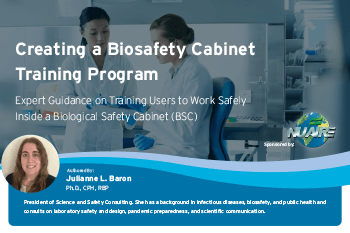
White Paper
Creating a Biosafety Cabinet Training Program
Creating a Biosafety Cabinet (BSC) Training Program is essential for laboratories working with hazardous materials. This white paper provides expert guidance on developing a comprehensive training program to ensure the safe and effective use of BSCs in clinical, pharmaceutical, research, and other laboratory settings.
The paper emphasizes the importance of BSC training in protecting personnel, products, and the environment. Using a BSC helps maintain an air curtain containing hazardous materials, ensuring that only HEPA-filtered air is released into the lab. Without adequate training, users may inadvertently disrupt airflow, breach the air curtain, or improperly manage materials, reducing the effectiveness of the BSC.
Training should incorporate various learning styles and adult learning principles, combining oral lectures, visual presentations, and hands-on practice. Emphasizing real-world applications and providing opportunities for trainees to practice in a controlled environment can significantly enhance knowledge transfer and retention.
The paper outlines key aspects of a BSC training program, including risk assessment, safe work practices, and competency assessments. It also highlights the importance of institutional support and accountability in promoting a culture of safety and continuous improvement.
Additionally, the white paper provides valuable resources for training materials, including documents, videos, and virtual reality demonstrations from reputable organizations like the CDC, NIH, and WHO. These resources can help trainers develop effective and up-to-date training modules.
Engaging with BSC manufacturers can also provide tailored resources and support specific to the equipment in use, enhancing the training program's effectiveness. Incorporating feedback from trainees can help identify barriers to proper BSC use and suggest practical solutions.
Overall, this white paper serves as a comprehensive guide for lab managers and safety officers to develop and implement a BSC training program that ensures safe handling of biohazardous materials, protects lab personnel, and maintains the integrity of scientific work.

